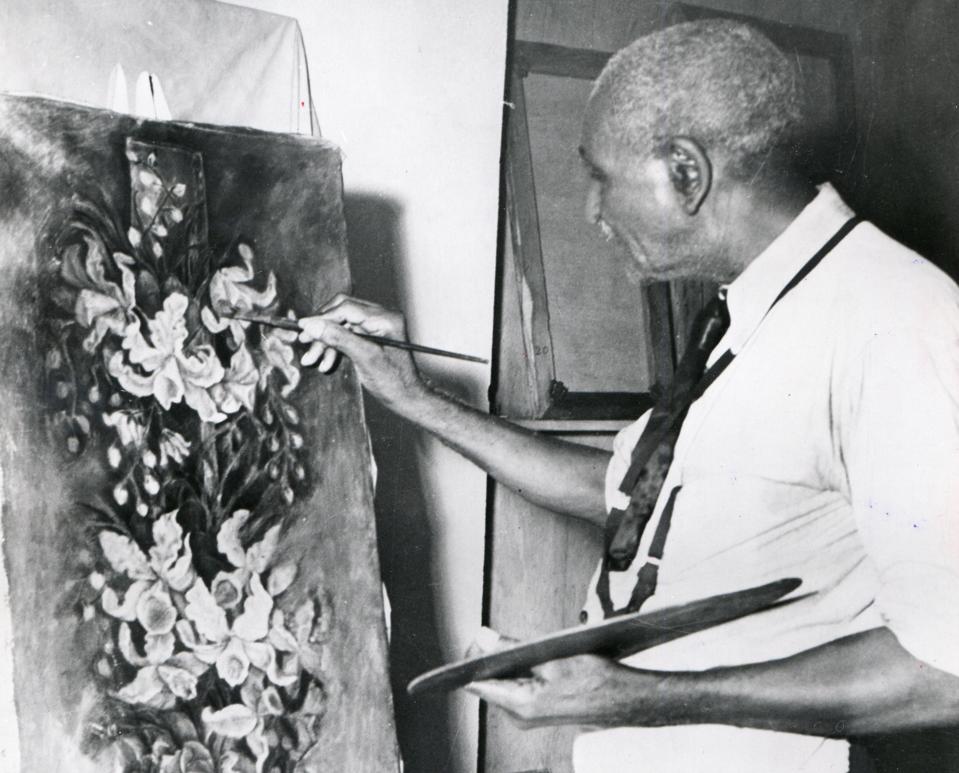George Washington Carver Was An Artist Long Before He Became A Peanut Scientist
Last month, The Getty Foundation announced the grant recipients for the 2024 exhibit series “Pacific Standard Time 2024: Art x Science x LA”. This event will include different galleries and institutes in California, which will each focus on the theme of science and art. While some of the planned exhibits focus on current and future science, one grant recipient is featuring an artist from science history. The California African American Museum received $120,000 for their exhibit “World Without End: The George Washington Carver Project”.
Although George Washington Carver is best known for his research on new uses for peanuts, he was also an artist. In 1941, two years before his death, Time Magazine featured a piece about Carver in which they mentioned that 71 of his paintings were being shown at Tuskegee at the time.

American scientist and educator Dr. George Washington Carver (1864 – 1943), works on one of his last … [+]
Getty Images
Carver spent most of his career as an agricultural researcher at Tuskegee, but he didn’t start his university career in science. When he initially enrolled in college (after searching for a place that would accept Black students in the 19th century) he studied art and piano at Simpson College in Indianola, Iowa. He’d always loved plants and particularly excelled at painting them — so much so that his art teacher, Etta Budd, encouraged him to enter one of his paintings to a local art exhibit, where it was selected as one of the artworks to represent Iowa at the World’s Fair in Chicago in 1893. Carver’s painting, “Yucca and Cactus”, got an honorable mention at the fair.
Despite his talents, Budd worried that Carver wouldn’t be able to make a living as an artist, so she suggested that he take his plant illustration skills to the botany department at Iowa State Agricultural College. After receiving his bachelor’s degree here in 1894 and his master’s in 1896, Carver took on a research position at Tuskegee Institute.
One of his initial interests was to help farmers increase the yield of their crops. Besides doing research, he invested a lot of time in talking to farmers and explaining the benefits of fertilization and crop rotation to restore nutrients to the soil.
MORE FOR YOU
Partly thanks to Carver, crop production in the South did indeed increase, but this led to a new problem. Now farmers were stuck with an agricultural surplus of crops they had harvested but could not sell. Carver’s idea, and the work he has become best known for, was to find new uses for crops to increase market demand.
During his time at Tuskegee, Carver invented more than a hundred new uses for sweet potatoes and over three hundred different ways to use peanuts. Not all of these methods were equally successful or even brought to market, but Carver’s job as a scientist was simply to figure out what could be done. And unsurprisingly, considering his art background, one of the new uses he found for peanuts was to develop paints.
He didn’t just use peanuts to make dyes, but other natural resources as well. Carver even created a line of household paints using pigments from Alabama soil that he envisioned would be more affordable for poor families.

Two women looking at a house paint exhibit in the George Washington Carver Museum. These paints were … [+]
Universal Images Group via Getty Images
Carver used some of his self-created paints for his art as well. In the 1941 profile about his art, Time Magazine noted that he used a series of plant-based earth tones created by his assistant A. W. Curtis Jr. In a way, Carver’s career had come full circle, from painting flowers for science to turning plants into paint.
Carver’s story is fascinating, and his life was so clearly influenced by both art and science, that it’s clear why the California African American Museum’s exhibit “World Without End: The George Washington Carver Project” will be included as part of “Pacific Standard Time: Art x Science x LA”. It doesn’t take place until 2024, but it’s something to look forward to if you’re in California.
